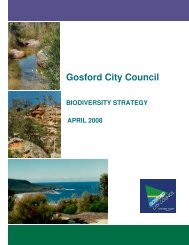Brisbane Water Plan of Management - Gosford City Council - NSW ...
Brisbane Water Plan of Management - Gosford City Council - NSW ...
Brisbane Water Plan of Management - Gosford City Council - NSW ...
You also want an ePaper? Increase the reach of your titles
YUMPU automatically turns print PDFs into web optimized ePapers that Google loves.
1.0 INTRODUCTION<br />
<strong>Brisbane</strong> <strong>Water</strong> is a tidal arm <strong>of</strong> Broken Bay located approximately 50 kilometres north <strong>of</strong><br />
Sydney within the <strong>City</strong> <strong>of</strong> <strong>Gosford</strong> Local Government Area. In a regional context, the area is<br />
strategically located on the established railway and freeway network between Sydney and<br />
Newcastle. (Refer to Figure 1.)<br />
<strong>Brisbane</strong> <strong>Water</strong> is a broad, shallow estuary with an approximate area <strong>of</strong> 2768 ha, connected to<br />
the sea through a comparatively narrow channel. (Refer to Figure 2.) The five major waterways<br />
which constitute <strong>Brisbane</strong> <strong>Water</strong> are:<br />
• Entrance Reach, comprising the waterway between the Rip Bridge and Half Tide Rocks.<br />
• Woy Woy Reach, comprising the waterway in the vicinity <strong>of</strong> Pelican Island, Rileys Island and<br />
St Huberts Island.<br />
• Kincumber Broadwater and Cockle Creek.<br />
• <strong>Brisbane</strong> <strong>Water</strong> Broadwater, which is the largest waterway area and, for the purpose <strong>of</strong> this<br />
report includes the whole <strong>of</strong> the areas upstream <strong>of</strong> Pelican Island, including Fagans Bay.<br />
• Woy Woy Bay and Woy Woy Inlet, which are separated from the Woy Woy Reach by a road<br />
and rail causeway.<br />
The estuary drains a catchment <strong>of</strong> 185 square kilometres, the principal tributaries being Narara<br />
Creek in the northwest and Erina Creek in the northeast.<br />
In the past decade the permanent population <strong>of</strong> the Central Coast has almost doubled from<br />
90,000 to around 170,000. The growth rate is three to five times higher than the <strong>NSW</strong> average.<br />
Such a large increase in population has generated problems associated with the use and<br />
enjoyment <strong>of</strong> <strong>Brisbane</strong> <strong>Water</strong> and creating conflicts and degradation to the natural environment<br />
around <strong>Brisbane</strong> <strong>Water</strong>.<br />
Urban areas have developed around the <strong>Brisbane</strong> <strong>Water</strong> foreshores with the major<br />
concentrations being centred at <strong>Gosford</strong> in the north and in the Woy Woy/Ettalong/Umina area<br />
in the southwest. Other smaller residential centres, including Green Point, Saratoga,<br />
Davistown, Empire Bay, Hardys Bay/Killcare and Pretty Beach, are scattered along the eastern<br />
foreshores.<br />
1.1 Need for a <strong>Management</strong> <strong>Plan</strong> for <strong>Brisbane</strong> <strong>Water</strong> and the purpose <strong>of</strong> Stage 1 and<br />
Stage 2<br />
This concern for the need to manage conflicts over the use <strong>of</strong> the resources <strong>of</strong> <strong>Brisbane</strong><br />
<strong>Water</strong> has led to <strong>Council</strong> resolving in December 1991, to establish a committee to<br />
undertake Stage I <strong>of</strong> a <strong>Plan</strong> <strong>of</strong> <strong>Management</strong> for the <strong>Brisbane</strong> <strong>Water</strong> Estuary within the<br />
<strong>City</strong> <strong>of</strong> <strong>Gosford</strong>.<br />
The goals <strong>of</strong> the <strong>Brisbane</strong> <strong>Water</strong> <strong>Plan</strong> <strong>of</strong> <strong>Management</strong> Committee is to:<br />
1 Protect, enhance and maintain <strong>Brisbane</strong> <strong>Water</strong> and its surrounds;<br />
2 Minimise the urban influence on the aquatic environment;<br />
3 Reverse undesirable impacts using catchment management principles by control <strong>of</strong><br />
development and carrying out improvement works; and<br />
<strong>Brisbane</strong> <strong>Water</strong> <strong>Plan</strong> <strong>of</strong> <strong>Management</strong> - July 1995 Page 1
















